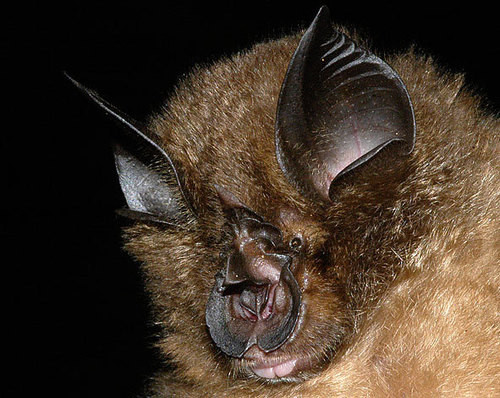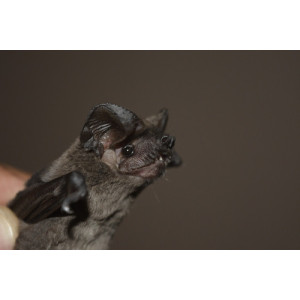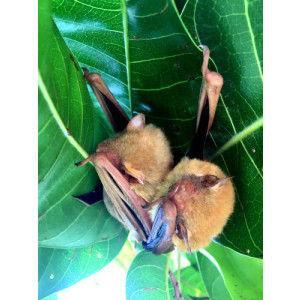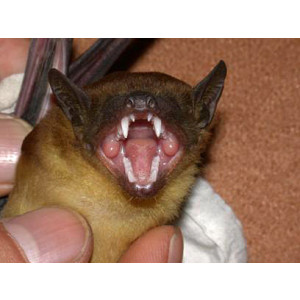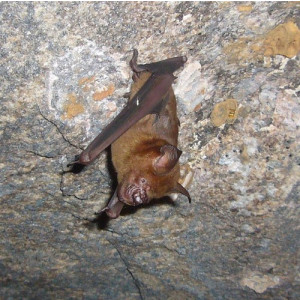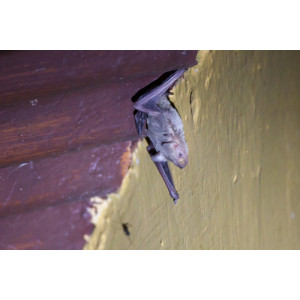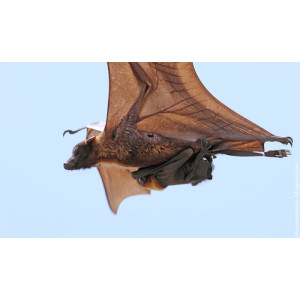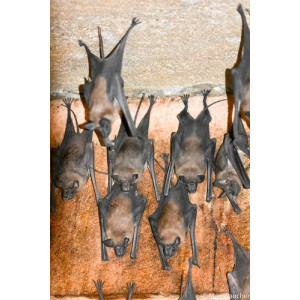Pearson’s Horse-shoe Bat Did you see this animal?
Scientific Name : Rhinolophus pearsonii
Family : Rhinolophidae
Order : Chiroptera
Class : Mammalia
Phylum : Chordata
Habitat : Forest, Caves and Subterranean Habitats (non-aquatic)
Description : These bats are medium-sized and have a distinctive horseshoe-shaped noseleaf that is used for echolocation. The horseshoe-shaped noseleaf helps to focus sound waves emitted by the bat's larynx, allowing them to locate prey in complete darkness. Pearson's horseshoe bat has relatively large ears, which are used to detect and amplify the returning echolocation signals.
Pearson's horseshoe bat has a unique fur coloration, which is reddish-brown on the upper body and dark brown or black on the lower body. They have a wingspan of around 25-30 cm and can weigh up to 16 grams. These bats are nocturnal and feed on insects, primarily moths, beetles, and flies.
Pearson's horseshoe bat roosts in caves, rock crevices, and abandoned buildings. They prefer roosting sites with high humidity levels, and they often form colonies of several hundred individuals. These bats are social animals and communicate with each other through a variety of vocalizations.
Pearson's horseshoe bats are active at night and use echolocation to navigate and locate their prey. They emit ultrasonic calls through their larynx, and these calls bounce off objects in their environment, creating an echo that the bat can use to determine the location, distance, and movement of objects. They are known to be agile flyers, capable of catching prey in mid-air.
Pearson's horseshoe bats have a polygynous mating system, where males mate with multiple females. Breeding usually takes place in the spring or summer months, and females give birth to one offspring at a time. The young are born helpless and require care from their mother until they are able to fly and forage for food on their own.
Pearson's horseshoe bat is listed as a least concern species by the International Union for Conservation of Nature (IUCN). However, like many other bat species, they face threats from habitat loss, disturbance of roosting sites, and hunting. Conservation efforts to protect their habitats and raise awareness about their importance in the ecosystem are crucial to their survival.
Pearson's horseshoe bat has a unique fur coloration, which is reddish-brown on the upper body and dark brown or black on the lower body. They have a wingspan of around 25-30 cm and can weigh up to 16 grams. These bats are nocturnal and feed on insects, primarily moths, beetles, and flies.
Pearson's horseshoe bat roosts in caves, rock crevices, and abandoned buildings. They prefer roosting sites with high humidity levels, and they often form colonies of several hundred individuals. These bats are social animals and communicate with each other through a variety of vocalizations.
Pearson's horseshoe bats are active at night and use echolocation to navigate and locate their prey. They emit ultrasonic calls through their larynx, and these calls bounce off objects in their environment, creating an echo that the bat can use to determine the location, distance, and movement of objects. They are known to be agile flyers, capable of catching prey in mid-air.
Pearson's horseshoe bats have a polygynous mating system, where males mate with multiple females. Breeding usually takes place in the spring or summer months, and females give birth to one offspring at a time. The young are born helpless and require care from their mother until they are able to fly and forage for food on their own.
Pearson's horseshoe bat is listed as a least concern species by the International Union for Conservation of Nature (IUCN). However, like many other bat species, they face threats from habitat loss, disturbance of roosting sites, and hunting. Conservation efforts to protect their habitats and raise awareness about their importance in the ecosystem are crucial to their survival.
Distribution in Bangladesh
References:
description written by:Asad U. Tanvir,Department of Zoology,Jagannath University,Dhaka; reviewed by:Muntasir Akash,Department of Zoology,University of Dhaka;Taxonomic Checklist:Red List of Bangladesh Volume 2: Mammals, 2015, IUCN; information sources:Wikipedia, Encyclopedia of life, iucnredlist.org. ; photo credit:The Darwin Initiative Centre for Bat Research(www.inaturalist.org/people/manuel_ruedi), photo copyright: iNaturalist.more information please contact with us.
description written by:Asad U. Tanvir,Department of Zoology,Jagannath University,Dhaka; reviewed by:Muntasir Akash,Department of Zoology,University of Dhaka;Taxonomic Checklist:Red List of Bangladesh Volume 2: Mammals, 2015, IUCN; information sources:Wikipedia, Encyclopedia of life, iucnredlist.org. ; photo credit:The Darwin Initiative Centre for Bat Research(www.inaturalist.org/people/manuel_ruedi), photo copyright: iNaturalist.more information please contact with us.
